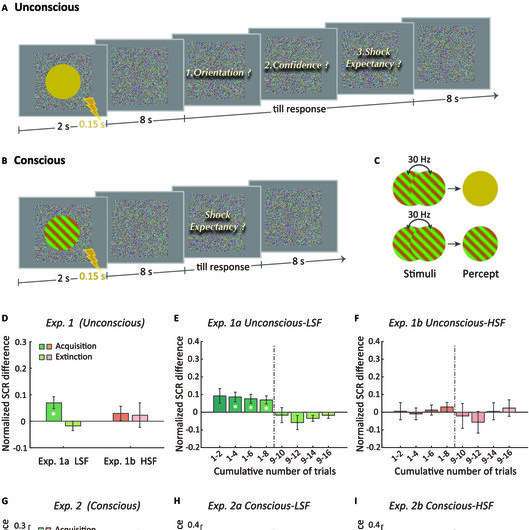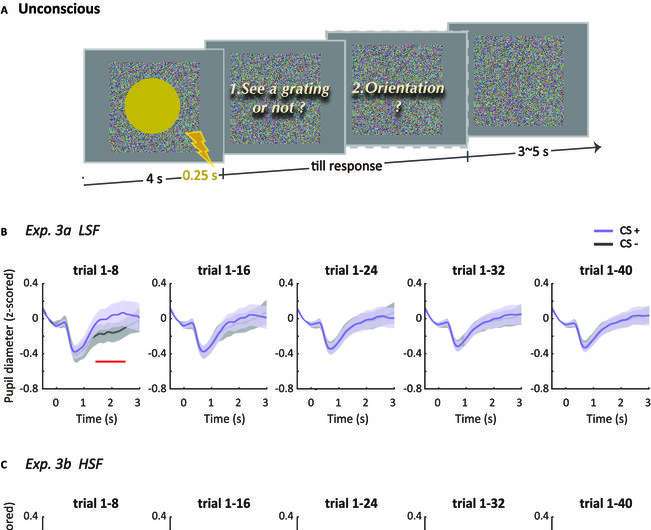This article has been reviewed according to Science X's editorial process and policies. Editors have highlighted the following attributes while ensuring the content's credibility:
fact-checked
trusted source
proofread
Study reveals key role of low-spatial-frequency information in unconscious fear conditioning

Humans have evolved a remarkable ability to effortlessly learn which stimuli in their environment predict potential threats, enabling them to survive in the complex world. According to the widely accepted Preparedness Theory, one can learn the association between emotionally prepared stimuli (e.g., fearful faces) and negative outcomes (e.g., electric shocks) even when these stimuli are outside of conscious awareness.
A collaborative research team led by Profs. Jiang Yi and Wang Liang from the Institute of Psychology of the Chinese Academy of Sciences (CAS) has challenged this theory by suggesting that the unconscious fear conditioning does not necessarily involve emotionally prepared stimuli, but is heavily dependent on the spatial frequency of the stimuli. The study was published in Research.
The spatial frequency component is a critical but understudied factor in unconscious fear conditioning. Many studies have shown that the processing of threat-related stimuli may rely predominantly on the low-spatial-frequency (LSF) components. However, it remains unknown whether the spatial frequency also plays an important role in the successful unconscious acquisition of conditioned fear.
In this study, the researchers used emotionally neutral grating stimuli as conditioned stimuli (CSs) and manipulated their spatial frequencies. At the same time, they used the critical flicker fusion frequency paradigm to manipulate the visibility of the stimuli. Electric shocks were used as the unconditioned stimuli.
By measuring skin conductance and pupil responses in a series of experiments, the researchers provided compelling evidence that the unconscious fear learning of emotionally neutral stimuli relies largely on the LSF components.

Emotionally neutral CS+ (associated with a negative outcome) with LSF, but not with high-spatial-frequency (HSF), elicited stronger skin conductance responses (SCRs) and larger pupil diameters compared to CS- (not associated with a negative outcome). Additionally, unconscious fear associations were rapidly acquired within a few trials but gradually habituated as the conditioning progressed. When the unconditioned stimuli was removed, the established fear conditioning rapidly disappeared.
In contrast, consciously perceived HSF and LSF stimuli elicited similar differences in SCRs. Furthermore, fear conditioning occurred slowly, and the conditioned fear was maintained for several trials after the removal of the unconditioned stimulus.
This study provides robust evidence that unconscious emotionally neutral stimuli can be efficiently associated with a negative outcome. It also shows that the unconscious fear processing relies more heavily on the LSF information, whereas the conscious fear processing has no apparent preference for spatial frequency.
In addition, this study confirms that pupil responses are as sensitive as skin conductance responses and can serve as effective physiological measures for assessing unconscious fear conditioning in humans.
In conclusion, these findings provide new insights into the mechanisms of unconscious fear learning and reveal the critical role of spatial frequency in the conditioning process. Moreover, they contribute to the overall understanding of anxiety disorders or phobias.
More information: Yujie Chen et al, Rapid Unconscious Acquisition of Conditioned Fear with Low-Spatial-Frequency but Emotionally Neutral Stimuli, Research (2023). DOI: 10.34133/research.0181



















